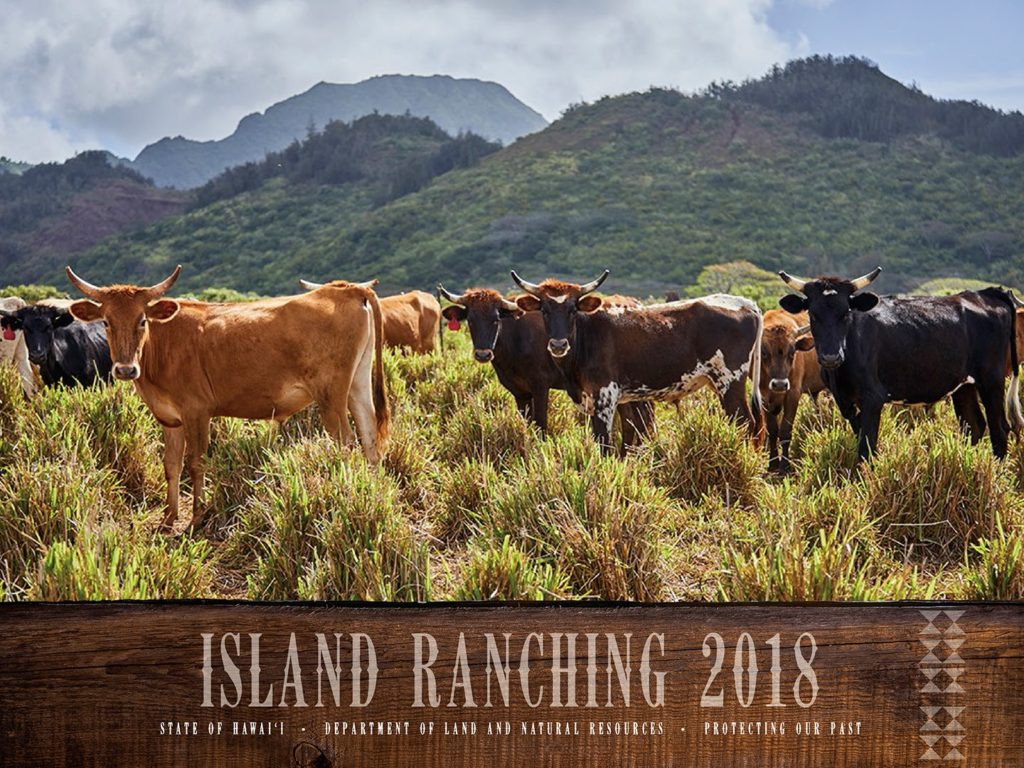Early History of Island Ranching is 2018 Calendar Theme

Island Ranching 2018 DLNR State Historic Preservation calendar. PC: cover photo by Ric Noyle
“Island Ranching” is the theme of the full-color 2018 calendar produced by the Department of Land and Natural Resources divisions of State Historic Preservation and Boating and Ocean Recreation, with the Hawai‘i Heritage Center.
In selecting the theme, DLNR representatives said the industry has played an impactful role in the evolving history of Hawaiʻi’s economy, industry, transportation, environment, culture and fashion.
DLNR Chair Suzanne Case said, “For more than 30 years the State Historic Preservation calendar has showcased the rich cultural and architectural history of Hawai‘i. DLNR and the Hawai‘i Heritage Center are deeply grateful for the continued support of the following corporate sponsors to share our outstanding treasures with the community,” she said.
The list of sponsors include the likes of: Alexander & Baldwin; Cultural Surveys Hawai‘i, Inc.; Division of Boating & Ocean Recreation; Fung Associates, Inc.; Hawaiian Electric Company, Inc.; INPAC Realty Inc.; Larry and Beatrice Ching Foundation; Edward Nakamura Jr.; and Wallace Theaters Management Corporation.
The calendar is designed by Viki Nasu Design Group with photography by Ric Noyle.
History of early ranching in Hawai‘i:
(as detailed by DLNR)
ARTICLE CONTINUES BELOW ADPre-contact period: The Polynesian settlers of Hawai‘i brought with them their primary plants used for food and other uses, and four animals, the moa (chicken), ‘īlio (dog), pua‘a (pig), and, inadvertently, the ‘iole (rat). The first three animals were the primary meat of the Hawaiians. Young ‘īlio and pua‘a were kept in compounds of the kauhale (village), hānai (fattened) on kalo (taro), ‘uala (sweet potato), and fish until they were large enough to be given in tribute to the ali‘i (chiefs), sacrificed in heiau (temples), or eaten at feasts. Other parts of the animals were used as ornaments or tools. The feathers of the moa decorated the ‘ulī‘ulī (gourd rattle) used in the hula, and ‘īlio teeth and pua‘a tusks were used to make bracelets and anklets worn by the hula dancers. The bones of the animals were used for tools, such as picks and fishhooks.
Post-contact period: Captain Vancouver introduced cattle to Hawai‘i in 1793 by dropping one bull and one cow at Kawaihae. He took the remaining five cows to Kealakekua as a gift for King Kamehameha I. The bull died, but a year later, Captain Vancouver returned with more cattle–four bulls and eight cows. A 10 year kapu (taboo) was placed on introduced cattle to feed on the rich green grasslands of Hawai‘i Island. These first cattle, or bullocks, were longhorn cattle and soon grew very wild. The first “ranchers” were bullock hunters, who rode to the uplands of Mauna Kea to shoot cattle or trap them in pits. The meat was used for food and the hides for export. By the 1820s, there were as many as 30,000 head of cattle on the islands. In 1815, John Palmer Parker landed in Hawai‘i and was employed as a bullock hunter. Gradually he began to accumulate land that became Hawai‘i’s renowned Parker Ranch on the Big Island.
Goats were the first domestic animals to be purposefully introduced in Hawai‘i. Captain Cook left goats on the island of Ni‘ihau in 1778. These were mainly hunted as wild animals. The first domestic sheep were introduced by Vancouver in 1793, but they did not thrive. A visitor in 1825 noted that he had found 8-10 dead sheep on Mauna Kea, stating that “they probably fled up there to seek refuge from the wild dogs.” A small sheep ranch was started on the Waimea Plains in 1856, but the first large scale sheep ranch was Parker Ranch’s Humu‘ula Sheep Station, established in 1873.
ARTICLE CONTINUES BELOW ADOther domestic mammal introductions soon followed. The first horse was left on the islands in 1803, and horses became common by the 1820s. Hawaiian women also rode horses, and to the displeasure of some foreign residents, they rode astride, with long, colorful split pā‘ū (skirts); as a result, women were called pā‘ū riders. The first of the famous paniolo (cowboys) from Mexico landed to work at the Parker Ranch in 1832, and many Hawaiians soon joined their ranks, preferring the free life of the range to the constricted work in the sugar cane fields. Horses became important work animals on the ranches, used to help catch and herd cattle.
By 1929, there were 41 primary cattle ranches in the islands, 19 on Hawai‘i Island, seven on Maui, three on O‘ahu, eight on Kaua‘i, and one each on Moloka‘i, Lāna‘i, Kaho‘olawe, and Ni‘ihau.
Ranching declined in Hawai‘i in the mid to late 20th century. In 1937, over 2 million acres in Hawai‘i were classified as “grazing lands.” By 2015, only 750,000 acres of land were classified as “pasture.”
Most of the current-day ranches have survived by diversifying into the tourist and visitor trade, adding helicopter tours, nature walks, horse trail rides, All Terrain Vehicle riding, and ziplines. Some, like Kualoa Ranch on O‘ahu, have been used as location shots for movies, from Mister Rogers, made in 1955, to Jurassic Park in 2016.
The remaining ranch lands also represent large conservation areas, and ranch owners work with government agencies, community groups, non-profits, and private companies to conserve the lands, watersheds, and forest zones of the Hawaiian Islands in trust for the Hawaiian people of tomorrow.










